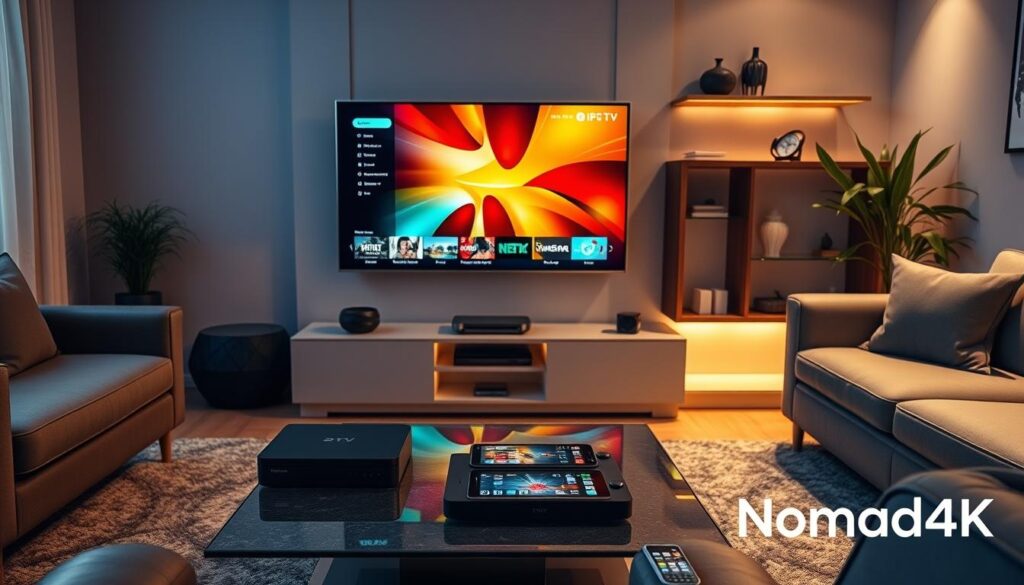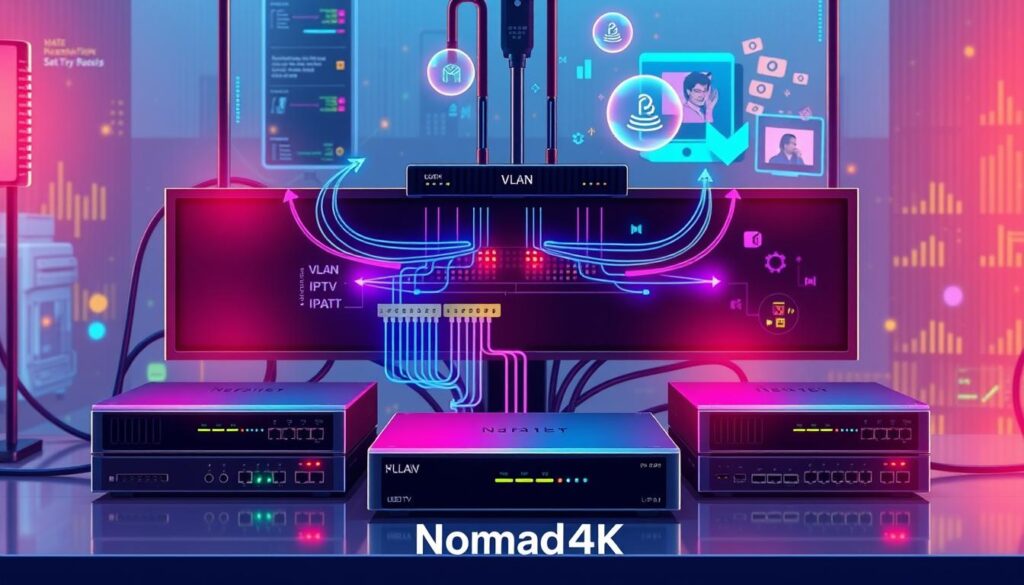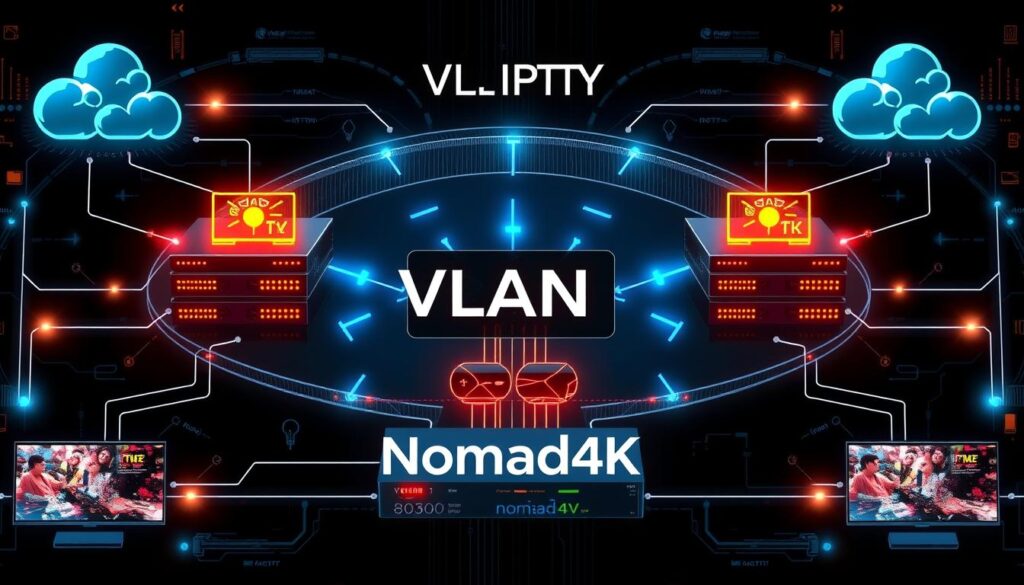
VLAN IPTV: Streamline Your Video Streaming Experience
Have you thought about how iptv in bulk can be improved with vlan iptv technology? Internet protocol television, or iptv, is now more popular. It brings flexibility, personalization, and interactivity to your viewing experience. By using virtual local area network iptv, you can make your streaming smoother.
This is key in today’s homes, where many devices stream high-quality videos. It makes iptv networking a must-have for your setup.
Key Takeaways
- Virtual local area network iptv can enhance your video streaming experience by reducing packet loss, latency, and congestion.
- Iptv vlan allows multiple devices to access iptv simultaneously without performance issues.
- Setting up iptv vlan on a tp-link router involves enabling the feature and configuring the required vlan id, along with possible quality of service settings.
- Iptv service providers may support vlan, and users can determine compatibility by checking the provider’s documentation or contacting customer support.
- One vlan can be used for multiple iptv services, simplifying network setup and management but requiring proper device configurations.
- Using iptv vlan can provide a more stable and secure streaming experience, making it an essential consideration for your iptv networking setup.
- Iptv vlan compatibility varies across tp-link router models, with modern routers more likely to support this functionality.
Understanding VLAN IPTV: Your Gateway to Enhanced Streaming
Streaming needs a reliable network. VLAN IPTV is a solution for better streaming. It improves quality, cuts buffering, and boosts security.
To start a VLAN IPTV system, you must set up your router and switch. You create a VLAN and assign it to switch ports. Then, you configure your router to connect the VLAN to the internet.
Setting up VLAN IPTV involves configuring it for IPTV devices. This ensures your IPTV works well. Learn more about Plex IPTV and its features.

VLAN IPTV brings better streaming, less buffering, and more security. It segments your network for better traffic management. This means your IPTV streams get the bandwidth they need.
When setting up VLAN IPTV, consider these features:
- Support for 802.1Q VLANs
- Layer 2 and Layer 3 switching
- IGMP snooping and MVR support
- Private VLANs and port-based VLANs
| Feature | Description |
|---|---|
| 802.1Q VLANs | Support for 802.1Q VLANs, a layer-2 feature |
| Layer 2 and Layer 3 switching | Support for both layer 2 and layer 3 switching |
| IGMP snooping and MVR support | Support for IGMP snooping and MVR |
Essential Steps to Configure Your VLAN IPTV Network
To set up your VLAN IPTV network, start by accessing your router’s settings. Enable the IPTV VLAN feature there. You’ll need to enter the VLAN ID, which is often 18 or 27. Remember, the VLAN ID might change based on your network and equipment.
When setting up your iptv vlan setup, think about Quality of Service (QoS) too. This helps make sure IPTV traffic gets priority. This ensures your streams are stable and high-quality. For more on IPTV setup, check out this website. It has a detailed guide on vlan configuration for iptv.
Some important things to keep in mind for iptv networking are:
- Using bridge-VLAN setups for different connections
- Assigning specific ports to VLANs, like LAN3 for the IPTV box
- Restarting the router or wireless interfaces after making VLAN changes
By following these steps and considering these points, you can set up your VLAN IPTV network well. You’ll get to enjoy smooth streaming.
Maximizing Performance Through VLAN IPTV Tagging
To get the most out of your IPTV, learning about iptv vlan tagging is key. This method tags IPTV traffic to make it a priority over other network traffic. This ensures your viewing is smooth and uninterrupted. When you integrate vlan and iptv, following best practices for iptv vlan deployment is vital. This helps avoid common problems and boosts performance.
Setting up Quality of Service (QoS) settings is a big part of iptv vlan tagging. You need to create rules to make sure IPTV gets enough bandwidth. This keeps your stream quality high. With QoS, your IPTV traffic gets the priority it needs for a better viewing experience. For more on IPTV services, check out this website. It talks about the perks of using IPTV with MAC ID for a more personal and secure watch.
Some top best practices for iptv vlan deployment are:
- Configuring VLAN tags to prioritize IPTV traffic
- Implementing QoS settings to ensure sufficient bandwidth
- Monitoring network performance to identify any problems
By sticking to these best practices and grasping the role of iptv vlan tagging and vlan and iptv integration, you can enhance your IPTV’s performance. This leads to a top-notch viewing experience.
| Best Practice | Description |
|---|---|
| Configure VLAN tags | Prioritize IPTV traffic for a smooth watch |
| Implement QoS settings | Make sure IPTV gets enough bandwidth |
| Monitor network performance | Spot and fix any issues to keep performance high |
Advanced Network Optimization Techniques
Optimizing your network is key for smooth streaming with iptv networking. Using vlan iptv protocols like MPEG-TS and RTP is a good start. These protocols are common in video streaming. Knowing how they work helps optimize your network for better video quality.
For virtual local area network iptv, managing traffic is vital. Make sure your iptv gets enough bandwidth to avoid interruptions. Techniques like Receive Side Scaling (RSS) and Jumbo Frames also boost your network’s performance.
Other advanced methods include using Gigabit Network adapters and switches. They can make your network up to 10 times faster. Also, VLAN Trunking Protocol (VTP) helps keep VLAN settings in sync across switches. For more tips, check out iptv resources.
By using these advanced techniques, you can get the best out of your vlan iptv system. Whether it’s for personal or business use, a well-optimized network is essential. It ensures reliable and efficient video streaming.
Conclusion: Elevating Your Streaming Experience with VLAN IPTV
Discovering VLAN IPTV changes your home streaming game. It keeps your IPTV traffic separate, ensuring smooth, high-quality video. It’s great for anyone who loves watching shows or movies at home.
Learning about VLAN IPTV systems and how to set them up is key. You’ll get the most out of your IPTV services. You can watch on multiple screens, access more channels, and enjoy a better viewing experience.
To make VLAN IPTV work well, stay up to date and adjust to your network’s needs. Keep an eye on its performance. With this article’s tips, you’ll get the best IPTV streaming at home.
FAQ
What is VLAN IPTV and how does it work?
VLAN IPTV is a tech that makes sure IPTV gets top priority on your network. It creates a special VLAN for IPTV. This means your video streams get the best bandwidth, making your viewing smooth and without interruptions.
What are the benefits of implementing VLAN for IPTV services?
VLAN for IPTV brings many benefits. It improves streaming quality and cuts down on buffering. It also boosts security by keeping IPTV traffic separate from other network activities. This ensures your streams get the bandwidth they need for a better viewing experience.
What are the key components of a VLAN IPTV system?
A VLAN IPTV system has a few key parts. The router sets up and manages the VLAN. The switch makes sure IPTV traffic is isolated and routed right. The IPTV device, like a set-top box or smart TV, connects to the VLAN to get the prioritized stream.
How do I configure a VLAN IPTV network?
Setting up a VLAN IPTV network takes a few steps. First, you access your router’s settings. Then, you enable the IPTV VLAN feature and enter the VLAN ID. You might also need to adjust other network settings, like QoS, to prioritize IPTV traffic.
What is the importance of VLAN tagging for IPTV traffic?
VLAN tagging is key for IPTV traffic. It lets the network know to prioritize video streams. By tagging IPTV packets, they’re handled correctly, improving streaming quality and reducing congestion.
How can I optimize my network performance for VLAN IPTV?
To get the most out of your VLAN IPTV network, use advanced techniques. QoS, traffic shaping, and packet prioritization can help. These methods ensure IPTV traffic gets the bandwidth and low latency it needs for a smooth streaming experience.







